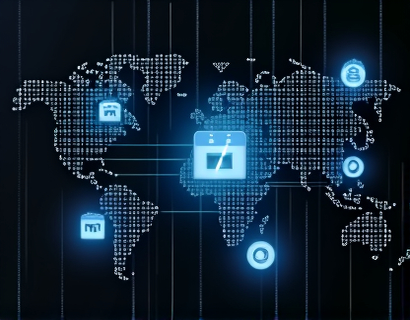Blockchain-Driven Asset Tokenization: Unlocking Liquid Value and Market Accessibility for Real-World Assets
Blockchain technology is revolutionizing the asset management industry by introducing a novel method for tokenizing real-world assets. This transformation not only enhances liquidity but also broadens market accessibility, making it an exciting development for both individual investors and large institutions. By integrating physical assets into the digital ecosystem through tokenization, blockchain provides a secure, transparent, and efficient framework for asset management.
The concept of asset tokenization involves representing a fraction of a physical asset, such as real estate, art, or infrastructure, as a digital token on a blockchain. These tokens can then be bought, sold, and traded on digital platforms, much like cryptocurrencies. This process democratizes access to previously illiquid assets, allowing a wider range of investors to participate in the market. The use of blockchain ensures that these transactions are immutable and verifiable, reducing the risk of fraud and increasing trust among participants.
Enhancing Liquidity through Tokenization
One of the primary benefits of asset tokenization is the enhancement of liquidity. Traditional real-world assets are often tied up for long periods, making it difficult for owners to access cash when needed. Tokenization changes this dynamic by breaking down these assets into smaller, tradable units. This fragmentation allows for more flexible trading and quicker transactions, as tokens can be bought and sold on various platforms with lower transaction costs compared to traditional methods.
For instance, a piece of commercial real estate valued at millions of dollars can be tokenized into thousands of smaller shares. Each share represents a fraction of the property, making it accessible to a broader investor base. This not only increases the potential buyer pool but also allows for more frequent trading, thus improving liquidity. Investors can now enter and exit positions more easily, which is particularly beneficial for those seeking short-term investment opportunities or looking to diversify their portfolios.
Increasing Market Accessibility
Asset tokenization significantly broadens market accessibility by lowering the barriers to entry. Traditionally, investing in real-world assets required substantial capital and often involved complex legal and financial processes. Tokenization simplifies this process by allowing investors to purchase tokens with relatively small amounts of cryptocurrency or fiat currency. This reduction in entry barriers opens up the market to retail investors who previously could not afford to invest in high-value assets.
Moreover, the global nature of blockchain technology means that asset tokenization is not limited by geographical boundaries. Investors from around the world can participate in the market, increasing the diversity of the investor base and potentially leading to more efficient pricing and better allocation of capital. This global reach also facilitates cross-border transactions, reducing the need for intermediaries and further lowering costs.
Security and Transparency
Security and transparency are paramount in any financial transaction, and blockchain technology excels in these areas. The decentralized and distributed nature of blockchain ensures that asset tokenization records are stored across multiple nodes, making it extremely difficult for any single entity to manipulate the data. Each transaction is recorded on a public ledger, which is visible to all participants, ensuring transparency and accountability.
Smart contracts, self-executing contracts with the terms directly written into code, play a crucial role in asset tokenization. These contracts automatically enforce and execute the terms of the agreement when predefined conditions are met. This automation reduces the need for intermediaries such as lawyers and brokers, further enhancing security and reducing transaction costs. The immutability of blockchain ensures that once a transaction is recorded, it cannot be altered, providing a high level of trust and reliability.
Use Cases and Industries
The applications of asset tokenization extend across various industries, each with its unique set of benefits. In the real estate sector, tokenization can facilitate fractional ownership of properties, making it possible for multiple investors to own a part of a building or a piece of land. This model can be particularly attractive for investors looking for rental income or long-term appreciation in property values.
In the art world, tokenization can democratize access to high-value art pieces. Collectors can purchase fractions of a artwork, making it more accessible to a broader audience. This not only increases liquidity for artists and collectors but also creates new revenue streams through token sales and royalties.
The infrastructure sector can also benefit from asset tokenization. Large infrastructure projects, such as bridges or highways, can be tokenized to raise capital from a wide range of investors. This approach can help finance projects that might otherwise struggle to secure traditional funding due to high upfront costs and long payback periods.
Challenges and Considerations
Despite the numerous advantages, asset tokenization is not without its challenges. Regulatory uncertainty remains a significant hurdle, as different jurisdictions have varying approaches to blockchain and tokenized assets. Investors and businesses must navigate a complex legal landscape to ensure compliance and avoid potential pitfalls. Additionally, the volatility of cryptocurrency markets can impact the value of tokenized assets, posing risks to investors.
Technical challenges also exist, such as the need for scalable and secure blockchain platforms capable of handling a high volume of transactions. Interoperability between different blockchain systems is another area that requires development to ensure seamless integration and interaction of tokenized assets across various platforms.
Future Prospects
The future of asset tokenization looks promising, with ongoing advancements in blockchain technology addressing current challenges. The development of more efficient and scalable blockchain solutions, such as layer 2 protocols and cross-chain interoperability, will enhance the performance and adoption of tokenized assets. Regulatory clarity is also expected to improve, with more governments and financial institutions recognizing the potential of blockchain and taking steps to create supportive frameworks.
As the ecosystem matures, we can anticipate increased innovation and the emergence of new use cases. The integration of asset tokenization with other blockchain applications, such as decentralized finance (DeFi) and non-fungible tokens (NFTs), will create new opportunities for investors and asset holders. The combination of these technologies can lead to more sophisticated financial products and services, further enriching the asset management landscape.
In conclusion, blockchain-driven asset tokenization is a transformative force in the asset management industry. By enhancing liquidity, increasing market accessibility, and providing robust security and transparency, tokenization opens up new possibilities for investors and asset owners. As the technology continues to evolve and gain regulatory acceptance, the potential for innovation and growth in this space is immense.










































